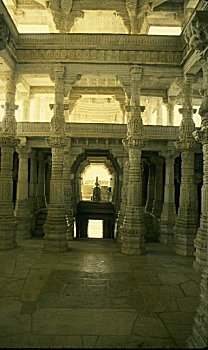Temples of Rajasthan
Last Updated: December 07, 2024
The great architectural movement which swept Rajasthan and the adjacent country from the 8th to the 11th century was really a later flowering of the virile development inspired by the Guptas during the 4th, 5th and 6th centuries. A great deal of this fine architecture, however, was destroyed during the earlier Muslim invasions.
As many as twenty-six temples were demolished to provide material for the Qutb Mosque at Delhi. Judging from the thousand temple pillars used in , the Arhai-Din-ka-Jhompra, another monument of the Afghan invaders at Ajmer, at least 50 temples must have been despoiled to build it. However, the exquisitely carved pillars in these mosques still give a fair idea of the beauty of Hindu workmanship in the post-Gupta phase of its development.

Dome of a Rajasthani Temple
Like the great literary master- pieces of this period, the architecture, too, testifies to high aesthetic ideals., The plastic embellishments in the temples frequently consist of foliage motifs and voluptuous feminine forms, thus reflecting a love of Nature and of beauty which also characterize the great literature of his age.
At Eran in the Saugor district of Central India is a group of buildings extending from the 5th to the 11th century which admirably exemplify the post-Gupta development. Among these are shrines dedicated to Varaha, Narasimha, and Vishnu. The ruins (now known as Ath Khamba -and Char Khamba) at Gyraspur are the remains of the pillared halls of temples belonging to the 10th and 11th centuries. The temple of Mala De dates from the 10th century. The Udayeswara temple at Udayaspur, built in red sandstone, is very like the Chandella edifices at Khajuraho. The village of Osia in Rajasthan is the site of some sixteen badly damaged and crumbling Brahmanical and Jain temples. The earlier of these, built in the 8th and 9th centuries, form a separate group, remarkable for the fact that no two temples in it are alike and that each of them displays an originality of composition quite rare in such a series. Of these, one dedicated to Surya, the Sun-God, is remarkable for its elegance and grace. The temple dedicated to Mahavira, however, is the most complete example of a Jain shrine at Osia. It consists of a richly decorated torana leading to an open porch, a closed hall, and the sanctum, all intact and dating from different periods. The stylized and stiff treatment of the pillar in the temple of Pipla Devi, built in the 10th century, illustrates the decline of this school of architecture. Contemporaneous with the post- Gupta style, there are examples of rock-cut temples of the Indo-Aryan type in Rajasthan. At Damnar, about fifty miles from Jhalra Patan, there is a rock-cut temple which has a somewhat complex composition of eight shrines. The Kotheswara temple at Pathari and the Udayeswara temple at Udayaspur belong to the same date.

Carved Sandstone Columns
Ranajpur Temple
The temple of Kalika Mata in Chittor and the temple of Lord Shiva at Baroli are notable examples of 10th century architecture in Rajasthan. The temple of Ekalinga Mahadev, twelve miles from Udaipur, is a structure of unusual design and was built by Bapa Rawal in the 8th century. The neighboring village of Nagda, an ancient site, has a large number of beautifully sculptured temples. Kumbha, the Rana of Mewar and husband of the celebrated Mirabai, built a number of temples at Chittor in the 15th century. Of these, a Shiva temple and two temples dedicated to Krishna are worthy of note.
![]()
See Also:
- Great Temples of North India
- Temples of India -- Detailed discussion on the history, and stylistics of some of the great temples of India.
![]()
References:
- K. L. Kamat, Na Rajasthanadalli, Akshara Prakashana
- K. L. Kamat, The Timeless Theater
- Govt. of India, The Temples of Rajasthan

